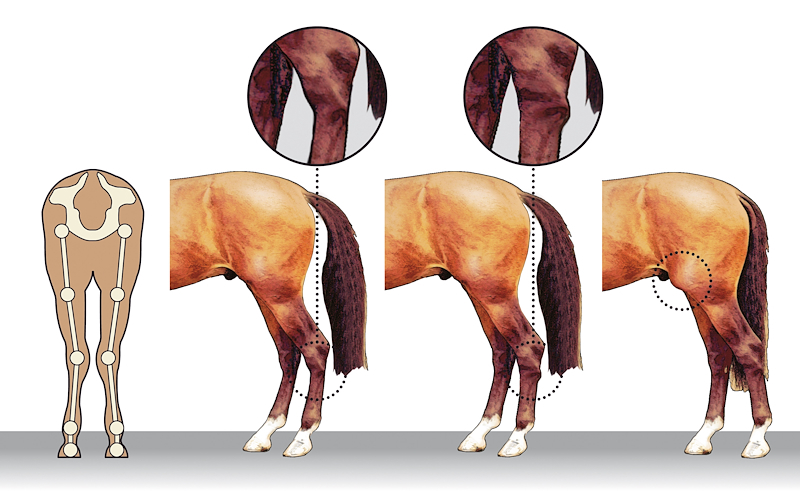Correct conformation: Hindleg angle and the hock
The KWPN pays close attention to correct conformation, which allows the horse to perform its work easily and, as a result, enjoy a long sport career. Correct leg conformation is an important part of this concept. Together with Dr. Harold Brommer of the University Clinic for Horses in Utrecht and inspectors Floor Dröge and Henk Dirksen, we once again shine a light on this subject.
Hind leg angle
Next, the jury assesses the angle of the gaskin relative to the hind cannon bone. If the angle is large, the hind leg is straight; conversely, if the angle is small, the hind leg is bent, and this stance is referred to as ‘sickle hocked’. Brommer: “The hind leg stance can certainly influence a horse’s durability. A horse with a hind leg that’s too straight usually can’t bend its hind leg as well. In contrast, a sickle-hocked hind leg is already more bent and therefore is more functional; but an angle that’s too small will result in a greater load. A straight hind leg bends less and therefore increases the risk of suspensory ligament problems, certainly when combined with a weak pastern angle. As a result, much more pressure is put on the suspensory ligament.” The most ideal hind leg conformation facilitates the most functional use. Dirksen: “For a jumper, we’d rather see a bit straighter hind leg than a sickle-hocked one, as long as it’s not too straight. A somewhat straighter hind leg can develop more power, but there are also enough show jumpers with a more sickle-hocked hind leg. A hind leg that’s too sickle-hocked, however, leads to a lot of wear and tear. But you see more exceptional cases here than with dressage horses.” Dröge: “A hind leg that’s too sickle-hocked appears to bend very well but can be far less effective for carrying. A somewhat straighter hind leg can develop more power; but if it’s too straight – certainly combined with a weak pastern stance – it can lead to suspensory ligament problems in dressage horses, which is a known issue.”
The hock
The jury then evaluates the hock conformation. Two abnormalities, which look very similar to the less knowledgeable person, may be found in the hock: an enlarged head of the bone spavin of the hind limb and curb. [LVWS1] Brommer explains: “With an enlarged head of the lateral splint bone of the hind limb, if you stand in front of the horse and look at the hock from the front, you’ll see a protrusion on the outside. The question then is always, what’s acceptable and what’s too large? There are gradations.” Sometimes the abnormality is so severe that, when viewing the cannon bone from the side, a protrusion can be seen at the rear. If we were to draw a line from the top of the point of the hock to the back of the fetlock, it should be straight. With a pronounced enlarged head of the lateral splint bone of the hind limb, this line is interrupted by a rearward protrusion. Brommer: “When the enlarged head of the lateral splint bone of the hind limb is only visible on the side, we call this a ‘classic enlarged head of the lateral splint bone of the hind limb.’ It actually never causes lameness and is therefore just a blemish. However, if we see an enlarged head of the lateral splint bone of the hind limb protruding at the back, then it’s usually an ‘inner enlarged head of the bone spavin of the hind limb’[LVWS2] . In these cases, the enlargement may also continue towards the center of the hock. Whether that’s the case and to what extent, can only be viewed on a radiograph. In such cases, there may be pressure on the suspensory ligament or the deep digital flexor tendon that’s pushed to the side. This does have clinical significance and can eventually cause irritation of the soft tissue and tendon structures and lameness in the horse. To a lesser extent, it doesn’t have to be a problem for that individual horse, but you don’t want it in your breeding program.”
The KWPN pays close attention to correct conformation, which allows the horse to perform its work easily and, as a result, enjoy a long sport career. Correct leg conformation is an important part of this concept. Do you want to know more about a correct conformation? Then order the book 'the KWPN Horse; selection for performance' here. KWPN members order the book for € 19.95 and non-members for € 24.50.























 KWPN Database
KWPN Database KWPN.tv
KWPN.tv KWPN Horses for Sale
KWPN Horses for Sale